Abstract
Scramjet operation requires a comprehensive understanding of the internal flowfield, encompassing fuel–air mixing and combustion. This study investigates transient flow and flame development within a HIFiRE-2 scramjet engine combustor, which features two opposing cavities and dual sets of fuel injectors—the upstream (primary) and downstream (secondary) injectors. These cavities function as flameholders, creating circulating flows with elevated temperatures and pressures. Shock waves form both ahead of fuel plumes and at the diverging and converging sections of the flowpath. Special attention is given to the interactions among these shock waves and the shear layers along the supersonic core flow as the system progresses towards a quasi-steady state. Driven by increased backpressure, bow shocks and disturbances induced by the normal, secondary fuel injection and the inclined, primary fuel injection move upstream, amplifying the cavity pressure. These shocks generate adverse pressure gradients, causing near-wall flow separation adjacent to both injector sets, which enhances the penetration and dispersion of fuel plumes. Once a quasi-steady state is achieved, a feedback loop is established between dynamic wave motions and combustion processes, resulting in sustained entrainment of reactive mixtures into the cavities. This mechanism facilitates stable combustion in the cavities and near-wall separation zones.
1. Introduction
The path to future supersonic and hypersonic transport requires a propulsion system capable of operating efficiently under extreme conditions [1]. Supersonic combustion ramjets (scramjets) are well-suited for the high Mach numbers encountered during these flights [2]. The supersonic intake air from an inlet is compressed by a series of oblique shock waves (shock train) inside an isolator [3]. In addition to air compression, the isolator separates and shields the inlet from the forward-propagating disturbances generated by fuel injection and chemical reactions within the combustor [4,5,6], which is configured to facilitate the desired mixing, combustion, and exhaust of a continuously supersonic flow.
Developing a commercially viable scramjet engine involves addressing a series of complex challenges, notably those posed by the high Mach number characteristics of internal flows [7]. The flow residence time within the scramjet engine flowpath is on the order of milliseconds [8], requiring a careful combination of fuel injection and flameholding schemes. These configurations create regions of slowed flow that allow an adequate time for the fuel and air to mix and burn. Various strategies to achieve optimal mixing and combustion are outlined in Table 1, which summarizes recent experimental and computational fluid dynamics (CFD) studies [9,10,11,12,13,14,15,16,17,18,19,20,21]. Vinogradov et al. [9] employed flush wall-mounted injectors immediately downstream of vertical pylons. These pylons deflect the intake airflow, inducing vortex shedding at their trailing edges. The fuel is directly injected into these vortices, establishing flameholding regions with highly mixed and decelerated flows. Another approach by Minato et al. [10] utilized a strut spanning the scramjet, introducing streamwise fuel injection from its rear, followed closely by a second strut. The gap between these struts forms a flameholding region with enhanced mixing due to crosswise vortices from the leading strut. Experimental setups using streamwise injectors at the ends of compression ramps were tested by Stouffer et al. [11] and Jacobsen et al. [12], employing hydrogen and ethylene fuels, respectively. These ramps act as small backward steps that shed vortices and slow the flow downstream, creating effective flameholding regions capable of sustaining combustion. Other explored configurations involved cavities along the sides of the combustor. Li et al. [13,14] computationally studied an ethylene fueled scramjet engine combustor with a single cavity, while Mathur et al. [15] performed experiments on a similar configuration using JP-7. The cavity flameholder, similar to the backward step models [11,12], features a significant expansion at the step followed by a compressive ramp that restore the original cross-sectional area. The large initial step produces a shear layer as the boundary layer flow is expelled into the cavity, enhancing the mixing of the fuel and air drawn from the core flow. Several cavity configurations have been explored, including both single and dual-cavity setups with tandem and opposing dual cavities. Storch et al. [16] performed CFD simulations to approximate the experimental results of the HIFiRE-2 scramjet test program, which utilized dual opposing cavities fueled by a methane–ethylene blend developed as a surrogate for cracked JP-7 fuel [17,18]. More recently, Tang et al. [19,20,21] carried out experimental and numerical studies on an axisymmetric scramjet configuration created by rotating a two-dimensional HIFiRE-2-like profile about its mid-height axis. This transformation converts the dual opposing cavities into a single annular cavity.

Table 1.
Fuel injection and flameholding methods in scramjets.
This paper builds upon existing research on various scramjet configurations, which have established a fundamental understanding necessary for a detailed exploration of flow and flame dynamics within scramjet engine combustors. Specifically, it extends the CFD research on the HIFiRE-2 configuration as detailed in [16]. The work herein examines the transient development of flow following the initial activation of fuel injectors. It covers the processes of fuel–air mixing and combustion within the cavities and throughout the combustor, progressing to the stabilization of flow into quasi-steady-state operation. The paper is organized as follows: Section 2 describes the theoretical formulation and numerical methods employed. Section 3 details the case description, including grid information and boundary conditions. Section 4 shows the verification and validation, and discusses the simulation results. Finally, conclusions and suggestions for future research are provided in Section 5.
2. Theoretical Formulation and Numerical Method
The simulations presented are conducted using ANSYS Fluent’s density-based solver for unsteady flows, which solves the conservations equations of mass, momentum, and energy alongside the species transport equation [22,23]. This solver has been employed and validated in scramjet research [24,25]. Following established practices in simulating the full scramjet flowpath [14,20], a reduced reaction mechanism is employed. Chemical reactions are treated using finite-rate kinetics based on the two-step reaction mechanism of Westbrook and Dryer [26]. Turbulence is addressed with the Reynolds-averaged Navier–Stokes equations with the shear stress transport (SST) k-ω model [27,28]. The turbulence–combustion interaction is treated with the eddy dissipation concept model [29], while the partially stirred reactor model provides combustion closure. The finite volume method is employed with a second-order implicit scheme for temporal integration. Spatial discretization is treated using Roe’s flux-difference splitting method coupled with a second-order upwind scheme. Parallelization is handled by the Intel Message Passing Interface to reduce the computational time.
3. Case Description
The computational domain for this study replicates the HIFiRE-2 experimental configuration, as shown in Figure 1. It includes an isolator, a combustor equipped with two opposing recessed cavity flameholders, and an exhaust nozzle. The isolator has a height h of 25 mm, a width w of 100 mm, and a length of 200 mm. The combustor extends over a length of 500 mm and begins with a short channel featuring body-side (top) and cowl-side (bottom) walls that diverge at an angle of 1.3 degrees, housing the primary injector arrays P1 and P2. This channel leads into cavities positioned on both the body and cowl sides, with cavity leading edges located 92 mm downstream from the combustor entrance. Each cavity has a depth d of 17 mm, a base length lb of 65 mm, and a compression ramp at 48 degrees. Following these compression ramps is another channel with body-side and cowl-side walls that also diverge at 1.3 degrees, and it contains the secondary injector arrays S1 and S2. The fuel, a binary mixture of ethylene and methane serving as a JP-7 substitute, has a methane fraction of 0.36. Fuel delivery is managed through four flush-mounted injector arrays—two primary (P1 and P2) and two secondary (S1 and S2), with injectors in each array spaced 25.4 mm apart. The outmost injectors are placed 12.7 mm from the spanwise walls. Primary injectors are mounted at a 15-degree angle relative to the body-side and cowl-side walls, while secondary injectors align perpendicularly to the combustor walls.
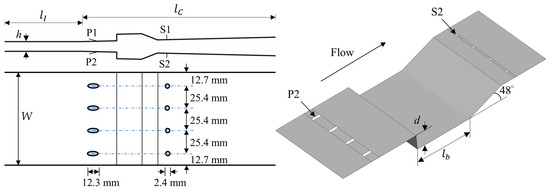
Figure 1.
Schematics of the HIFiRE-2 combustor.
The flight is assumed to have an altitude of 30 km, with an ambient temperature of 226 K and pressure of 1.2 kPa. Assuming a flight Mach number of 5.84, the airflow at the isolator inlet has a Mach number of 2.51, and its static pressure and temperature are determined accordingly. At the exhaust nozzle outlet, where the flow is predominately supersonic, flow properties are extrapolated from the interior points. All walls are assumed to be adiabatic and no-slip conditions are enforced. The fuel injection ports are assumed to operate under sonic conditions with a total temperature of 300 K. The static temperature is calculated using the isentropic relation. The pressures are adjusted to maintain a global equivalence ratio Ф = 0.65 within the combustor, with an equivalence ratio of 0.15 from the primary injectors and 0.5 from the secondary injector.
Both two-dimensional and three-dimensional simulations are considered in the present work. Figure 2 shows the mesh topologies for both domains. The two-dimensional domain, which represents the spanwise-integrated flowfield, was used primarily to assess grid resolution and study grid convergence. The three-dimensional domain, on the other hand, was employed to resolve the flow and combustion processes in detail. Additional information is provided in Section 4.
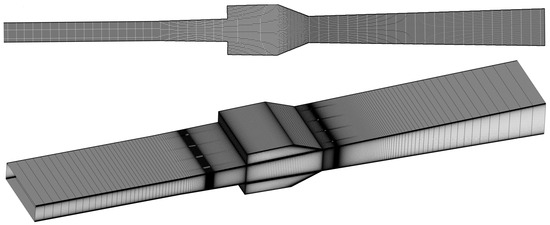
Figure 2.
Mesh topology: (top panel) two-dimensional and (bottom panel) three-dimensional domains.
4. Results and Discussion
To access grid convergence within a feasible turnaround time, three levels of grid resolution were employed for a two-dimensional domain representing a spanwise-integrated flowfield. The mesh topology is shown in Figure 2. The coarsest mesh, termed Level 1, contains 4500 cells. Subsequent refinement, applying a refinement ratio of two in both dimensions, results in a Level 2 mesh consisting of 18,000 cells, while the finest mesh, Level 3, has 73,000 cells. Following the methodology of Roache [30], the Grid Convergence Index (GCI) method was utilized across the three meshes, with each successive grid (i and i + 1) refining such that grid i + 1 is finer than grid i. The GCI between two successive grids is defined as
where FS is the safety factor, which is recommended to be 1.25 when using three or more grids; represents the relative error between two grids; r is the grid refinement ratio, set as two in this study; and f denotes a flow property. The order of convergence, Π, is defined as
Nonreacting airflow within the scramjet flowpath is simulated across three mesh levels. The axial locations where pressure begins to rise due to cavity rear ramps that are considered a key flow property. The computed values at each mesh level along the centerline are = 400.918, = 405.804, and = 407.726 mm. These yield relative errors of = 0.0121 and = 0.0047, leading to an order of convergence . Subsequently, it is determined that = 0.00988 and = 0.00384. Small GCI values indicate low numerical uncertainty from spatial discretization. As the simulations are performed on systematically refined grids designed to minimize the discretization error, the results are expected to fall within the asymptotic range, confirmed by evaluating the ratio that approximates unity. In this study, the computed value is 1.012, thereby confirming grid convergence.
Following the confirmation of grid convergence on the two-dimensional domain, a three-dimensional mesh, corresponding to the Level 3 grid resolution, was generated and employed for subsequent simulations. As shown in Figure 2, the mesh comprises a total of 11.9 million structured cells, with the domain divided into 11 subdomains to facilitate local refinement near the primary and secondary injectors, as well as in the early mixing regions immediately downstream of the injector arrays. Grid cells are clustered toward the walls, achieving at the centers of the first cells and thereby ensuring full resolution of the logarithmic portion of the boundary layers.
The investigation of physical processes within the scramjet flowpath is carried out in two stages. The first stage is a transient cold flow to establish the airflow from inlet to outlet, with reaction processes deactivated. This stage is executed twice: initially with the fuel injectors off, and subsequently with them active. The second stage begins once the cold flow without fuel injection reaches a steady state. During this stage, the reaction processes are activated, and all injectors deliver fuel at the targeted mass flowrates.
4.1. Non-Reacting Flowfields
The transient cold flow was analyzed both with and without fuel injection. In the three-dimensional simulations of non-reacting flowfields, wall pressures are extracted from the top of the spanwise midplane at z/W = 1/2 once converged solutions are achieved (after a simulation time of 4 ms). These pressures are then compared with ground test results from the HIFiRE-2 experiment [16]. As depicted in Figure 3, where P and S denote the streamwise locations of the primary and secondary injectors, respectively, the simulated wall pressures closely align with the experimental results across the isolator and through most of the combustor section. Near the front ramps of the cavities at x = 292 mm, a sudden flow expansion leads to a steep pressure drop. In contrast, near the rear ramps at x = 360 mm, flow compression results in a pressure rise. When the injectors are off, as the airflow exits the cavity region, it encounters another geometric expansion that causes a sharp drop in pressure at around x = 400 mm. Conversely, when the injectors are on, mass addition from the secondary fuel injection mitigates the pressure drop due to flow expansion and offsets the effect, with the pressure profile showing a spike immediately after the secondary injector arrays and closely matching the experimental data.

Figure 3.
Wall pressure distribution along the top of the midplane [16] (steady-state cold flows).
Figure 4 compares steady-state cold flows near the cavities with and without fuel injections. The pressure contours are overlaid with two-dimensional streamlines, and the temperature contours are overlaid with sonic lines on the spanwise midplane. In both scenarios, the flow expands upon entering the cavities, generating expansion waves near the front ramps and causing a notable decrease in pressure in the early part of the cavity region. Near-wall shear layers, marked by clustered streamlines and sonic lines, are lifted towards the cavities. Flow recirculation occurs within these cavities, creating a high local temperature conducive to ignition. Although the entrainment of primary fuel plumes, which are supplied at a total temperature of 300 K, slightly reduces the cavity temperature, it still reaches approximately 1300 K. In the later part of the cavity region, the flow converges, inducing recombination shock waves and an increase in wall pressure starting near x = 360 mm, as shown in Figure 3. At the end of the cavity rear ramps, the diverging geometry of the combustor walls leads to a pressure reduction near the walls, whereas intersecting shock waves create a high-pressure zone at the center of the flowpath. Specifically, in the scenario without fuel injection, the near-wall pressure reduction features distinct bands of low pressure at x = 406 mm. Conversely, in the scenario with fuel injection, the near-wall pressure reduction is disrupted by the secondary fuel injection, which triggers additional compression shock waves. These intersecting shock waves, stemming from the recompression of lifted shear layers on the cavity rear ramps and the secondary fuel injection, form a pronounced high-pressure region in the core flow. In both scenarios, the shock waves interact and reflect off the walls or near-wall shear layers as they travel towards the exhaust nozzle, forming a shock train downstream.

Figure 4.
Steady-state cold flows near cavities: (left panels) pressure distributions overlaid by streamlines, and (right panels) temperature distributions overlaid by sonic line on the midplane.
Besides a slight reduction in cavity temperature, the activation of fuel injectors introduces additional mass and momentum, causing localized pressure elevations and acting as a flow obstruction. As observed in Figure 3, the primary fuel injection slightly increases the pressure upstream the cavities at around x = 255 mm, while the secondary fuel injection significantly elevates it downstream of the cavities starting from x = 405 mm. These changes influence the shear layers entering the cavities, reducing the recirculation regions within them. Additionally, the formation and movement of shock waves are affected. Bow shocks form at the primary injectors and propagate downstream. Near the secondary injectors, strong shock formation and interaction create substantially larger near-wall subsonic zones, indicating a reduced effective flow passage and shortened intervals between consequent shock interactions.
4.2. Flow and Flame Transients in Reacting Flowfields
The reacting flow simulation initiates from the converged cold flow without fuel injection. As shown in Figure 4b, activating fuel injections leads to the formation of bow shocks ahead of the injectors, which are particularly prominent at the secondary injectors using normal injection angles. This effect reduces the pressure discrepancies previously noted between experimental and numerical (no fuel injection) non-reacting flowfields. As the fuel injection and fuel–air reaction progress, the flowfield changes progressively. Figure 5 shows the temporal evolution of the wall pressure distribution along the top edge of the spanwise midplane, where P and S denote the streamwise locations of the primary and secondary injectors, respectively. Shortly after the initiation of the reacting flow simulation (t = 0.2 ms), pressure increases are observed downstream of the cavities near the secondary injectors. The introduction of secondary fuel and the ensuing combustion create disturbances that, driven by backpressure, move upstream and elevate pressure within the cavities. By t = 1 ms, these disturbances reach the cavity entrances and propagate towards the primary injectors. Although the pressure profiles within the cavities are lower than those observed in the experiments, they display a similar trend, especially as the simulation proceeds. Near the primary injectors ahead of the cavities, bow shocks form and are coupled with increased backpressure, generating additional pressure disturbances. As the simulation continues, these disturbances propagate upstream towards the isolator through the subsonic regions of the boundary layers, further increasing the pressure to align with experimental measurements.
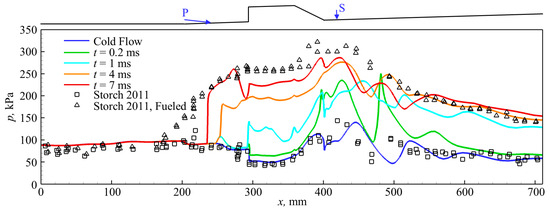
Figure 5.
Wall pressure distributions along the top midplane (reacting flow) [16].
4.2.1. Isolator Flowfield
The isolator of the scramjet, as its name suggests, serves to isolate the inlet flow from the combustor flow and acts as a compressor to raise the static pressure of the intake air. Disturbances such as shocks at the injector arrays, generated within the combustor region, propagate upstream. Without an isolator, these disturbances could adversely impact the operation of the inlet. However, the use of an isolator to confine these disturbances introduces a trade-off, as the shock train inside the isolator causes total pressure losses to the flow. Figure 6 shows the pressure gradient contour inside the isolator and the profiles of static pressure and axial velocity along its centerline during steady-state operation prior to the arrival of pressure disturbances from downstream. Even during the no-injection cold flow phase, oblique shocks are triggered when supersonic air enters the isolator, caused by leading-edge effects. These initiate a shock train where oblique shocks reflect off the top and bottom walls and propagate into the expansion region that houses the primary fuel injectors. In the reacting flow phase, the activation of fuel injection and subsequent fuel–air reactions increase pressure in the combustor region, strengthening the shock train. Meanwhile, the impingement of these shocks on the primary fuel plumes could substantially reduce the penetration of the plumes. As illustrated in Figure 6, the shock train decelerates and compresses the airflow before it enters the combustor section. To minimize total pressure losses from the shock train, it is crucial to ensure that the isolator does not exceed the necessary length protecting the inlet from combustor effects. The HIFiRE-2 isolator measures 0.2 m in length and contains approximately four shock train segments. Each segment consists of a left-running and a right-running shock, their intersection, and their reflections from the walls, which initiates the subsequent segment.
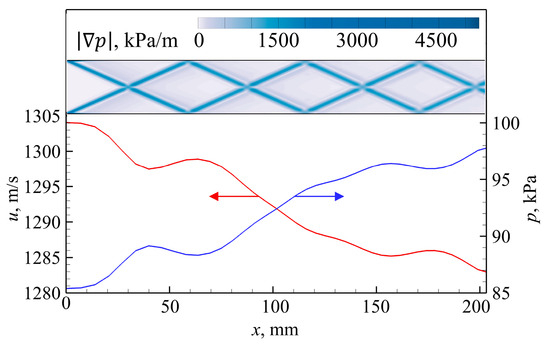
Figure 6.
Isolator flowfield: (top panel) contour of the pressure gradient magnitude and (bottom panel) profiles of static pressure and axial velocity along the centerline.
4.2.2. Combustor Flowfield
Upon activation of the fuel injectors, the combustor flowfield is significantly altered by the interaction between the axial airflow and the transverse fuel plumes. Figure 7 shows the temporal evolution of pressure and Mach number distributions on the combustor midplane. The pressure contours show the supersonic core flow enclosed by isosurfaces of the unity Mach number, which are color-coded based on local pressure values, and fuel plumes are highlighted by isosurfaces of colored in red. Overlaid on the Mach number contours are two-dimensional streamlines. Early in the reacting flow development at t = 1 ms, the primary fuel plumes align closely to the top and bottom walls, expanding only within the cavities. The secondary fuel plume penetration is greatest from injectors near the sidewalls as a result of flow separation at the corners. Fuel plumes from the inner injectors remain confined close to the top and bottom walls. While the majority of the flowpath in the combustor section is supersonic, the downstream nozzle develops substantial near-wall subsonic regions as a results of shock motions, similar to those discussed in Figure 4. As the simulation proceeds to t = 4 ms, the primary fuel plumes penetrate deeper into the core flow due to flow separation, which is induced by the adverse pressure gradient caused by bow shocks ahead of the primary injectors and further compounded by the forward propagation of shocks due to increased back pressure. A narrow, high-pressure core flow is observed, resulting from shock waves reflecting off the lifted shear layers. For the secondary fuel plumes, while the penetration of the outer plumes remains almost unchanged, those from the inner injector penetrate significantly deeper, facilitated by a large flow separation region. The downstream nozzle region is predominantly subsonic, indicating strong thermal choking and a substantial reduction in the effective flow passage during the transient stages of ignition and flame development. Around t = 7 ms, the primary fuel plumes disappear shortly after their injection due to combustion. The leading oblique shocks, located upstream of the primary injectors, continue to advance forward due to high backpressure inside the cavities. Downstream of the cavities, extensive flow separation along the sidewalls creates large regions of subsonic flow near the walls, with a supersonic core flow in the flowpath center. The secondary fuel plumes from the outer injectors exhibit a noticeable increase in penetration. Further analysis of additional data for t > 7 ms reveals little change over time, suggesting that the reacting flowfield has reached a quasi-steady state.
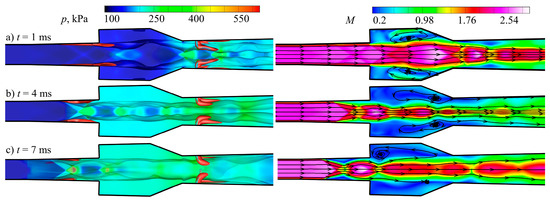
Figure 7.
Temporal evolution of combustor flowfield on the midplane: (left panels) pressure distributions overlaid by isosurfaces of M = 1 colored by pressure and isosurfaces of YC2H4 = 0.189 colored in red; and (right panels) Mach number distributions overlaid by streamlines.
The fuel from the primary and secondary injector arrays is introduced into the scramjet flowpath similarly to the classical jet-in-crossflow scenario with a supersonic crossflow. Figure 8 shows the near injector flowfields at t = 4 ms. Isosurfaces of kPa/m are color-coded based on the local pressure gradient magnitude, while isosurfaces of are colored in red. Also shown are the contours of on the side and bottom walls. Near the primary injectors, fuel penetration generates a bow shock ahead of each injector, a three-dimensional structure that envelopes the windward fuel plume. Both mass addition and aerodynamic blockage disrupt the surrounding flowfield, inducing two additional shocks further upstream in the corner separation regions. Near the secondary injectors, normal fuel injection induces strong bow shocks. The combined effects of injector obstruction and shock-induced pressure gradients lead to the formation of large separation regions in the immediate downstream. This allows the fuel plumes to penetrate deeper towards the core flow. The bow shocks ahead of the secondary injector are further influenced by shock waves originating upstream.
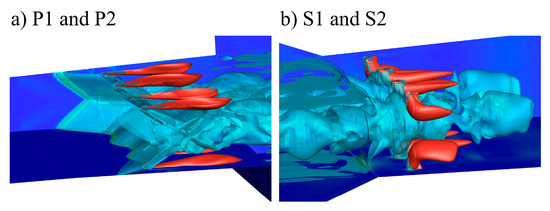
Figure 8.
Flowfield near the primary and secondary fuel injectors at t = 4 ms: isosurfaces of kPa/m are colored in blue, and isosurfaces of are colored in red.
Figure 9 shows contours of temperature and combustion products on transverse planes located downstream of the primary and secondary injectors. Immediately after the primary injectors at x = 270 mm, elevated temperature and combustion products are primarily concentrated near the top and bottom walls. Although spanwise spreading occurs, these regions remain disconnected. Along the sidewalls, a relatively high temperature is observed without corresponding combustion product concentration, suggesting possible heat transfer between the top and bottom walls. After the secondary injectors at x = 440 mm, enhanced penetration of fuel plumes enables reaction zones to extend deeper into the core flow, significantly reducing the width of the colder central region. These plumes also spread spanwise and coalesce. Additionally, high-temperature zones expand along the sidewalls, driven by separation-induced mass and heat transfer.
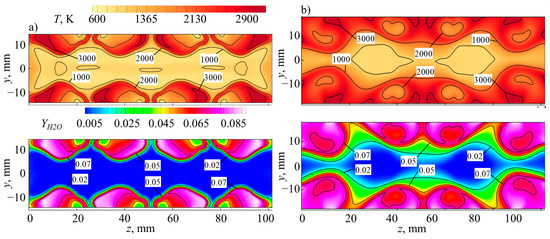
Figure 9.
Distributions of temperature and combustion products at 4 ms aft of (a) the primary injectors, x = 270 mm, and (b) secondary injectors, x = 440 mm.
4.2.3. Dynamics of Shock Waves
As discussed earlier, the formation and propagation of shock waves influence the fuel injection, fuel–air mixing, and reactions in the combustor. Since the shock waves caused by leading-edge effects in the isolator are considerably weaker than those generated in the combustor, this analysis focuses on the dynamics of shock waves within the combustor region.
Figure 10 shows snapshots of the pressure gradient magnitude near the injectors on the plane of z/W = 3/8, which slices through the fuel injectors. These snapshots are overlaid with isolines of at various values. Throughout the simulation, the isolator shock train exhibits minimal movement and is indiscernible in the figures due to weak gradients. The first significant gradients are observed at approximately x = 210 mm, resulting from flow expansion in the 1.3-degree divergent section. By t = 0.2 ms, prominent gradients at x = 240 mm and x = 250 mm appear at the leading and trailing edges of the primary injectors. Near the cavity entrances at x = 290 mm, strong gradients indicate forward-propagating disturbances originating from the bow shocks ahead of the secondary injectors. The fuel plumes from the primary injectors remain close to the walls, while those from the secondary injectors penetrate deep into the core flow, inducing strong pressure gradients ahead of them. By t = 4 ms, disturbances from the secondary injectors merge with those from the primary injectors, enhancing shocks near the primary injectors. The resultant strong adverse pressure gradients behind these shocks lead to flow separation, allowing the primary fuel plumes to penetrate deeper into the core flow. At x = 278 mm, shock waves reflect off the fuel plumes, forming expansion fans and pushing the plumes towards the walls just before entering the cavities. Similar phenomena are observed near the secondar injectors at x = 425 mm. As the flowfield reaches its quasi-stable state at t = 7 ms, the separation zones near the primary injectors expand further upstream, inducing strong bow shocks stemming from x = 230 mm. As shown in Figure 7 (on the midplane instead), primary fuel is issued in subsonic zones that are conducive for mixing, resulting in significant consumption of the primary fuel before it enters the cavities. These changes in combustion zones alleviate thermal choking downstream of the cavities, reducing shock interactions on the z/W = 3/8 plane.
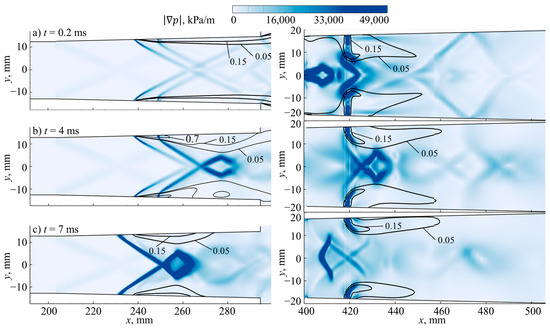
Figure 10.
Temporal evolution of pressure gradient magnitudes overlaid with isolines of on the plane of : (left panel) near the primary injectors, and (right panel) near the secondary injectors.
Due to the three-dimensional nature of shock waves, their impact on the combustor flowfield varies across different locations. Figure 11, Figure 12 and Figure 13 show the distributions of pressure gradient and density gradient magnitudes across three planes, slicing through the inner injectors at z/W = 3/8, the spanwise midplane, and the transverse mid-height plane (y = 0), at three distinct time instants. At t = 1 ms (Figure 11), the primary fuel plumes are marked by strong density gradients near the top and bottom walls, which lift upon entering the cavity region, forming shear layers that separate the core flow from the recirculating cavity flows. Bow shocks, originating from the leading and rear edges of the primary injectors, merge as they propagate into the cavity region and reflect off the shear layers at about x = 340 mm. This intersection creates expansion fans and drives the shear layers towards the top and bottom walls, thereby enhancing flow entrainment into the cavities and demonstrating the flameholding capabilities of the cavities. Near the cavity rear ramps, these shear layers deflect towards the core flow due to geometric convergence. Flow recompression near the rear ramps also triggers additional shock waves and shear layers around x = 360 mm, which are particularly prominent on the mid-height plane and near the sidewalls. The secondary injectors, mounted perpendicular to the walls and operating at a higher flowrate, induce more pronounced bow shocks. The recompression shocks from the cavity rear ramps intersect with these shocks, leading to complex interactions in the x = 390–460 mm region, alongside near-wall flow separations that extend both transversely and spanwise. These regions of separated flow facilitate the heat transfer observed in Figure 9. Distinct shock-induced shear layers trail into the downstream nozzle region.
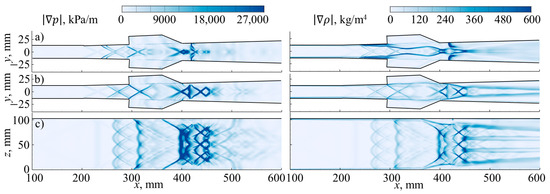
Figure 11.
Distributions of pressure gradient and density gradient magnitudes at on the planes (a) , (b) , and (c) .
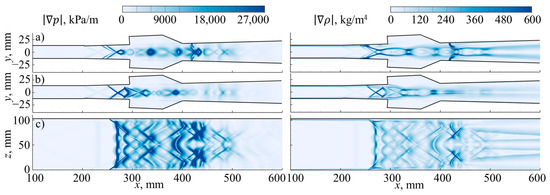
Figure 12.
Distributions of pressure gradient and density gradient magnitudes at on the planes (a) , (b) , and (c) .
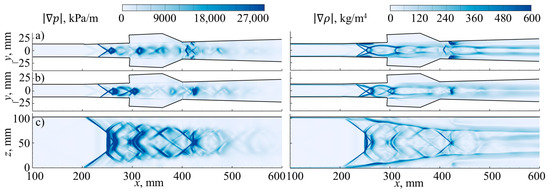
Figure 13.
Distributions of pressure gradient and density gradient magnitudes at on the planes (a) , (b) , and (c) .
Figure 12 shows the combustor flowfield at a further developed stage at t = 4 ms. The core flow has noticeably shrunk, as demonstrated by the density gradient magnitudes. Near the primary injectors, fuel plumes penetrate deeper into the core flow. Bow shocks stemming ahead of the injectors intersect these plumes even before entering the cavities at x = 280 mm, deflecting them towards the top and bottom walls. Upon entering the cavities, these plumes are pushed towards the core flow by the already established high-pressure inside the cavities (as shown in Figure 7b). The expansion waves reflect off these shear layers, generating compression at x = 320 mm and subsequent expansion at x = 340 mm, until strong recompression waves form around x = 380 mm due to geometric convergence. This wave–shear layer interaction significantly restricts the passage of core flow, and a similar phenomenon was observed in earlier research on confined supersonic flow with rectangular cavity regions [31]. With the axial intervals between wave–shear layer interactions shortening due to reduced core flow passage, coupled with disturbances propagating forward from the downstream secondary injectors, complex wave patterns emerge in the combustor region, extending from upstream of the cavities to the downstream nozzle. Compared to t = 1 ms (Figure 11), due to the reduced local axial flow speed, the secondary plumes at t = 4 ms are more likely to expand transversely and spanwise, promoting a more uniform flowfield in the downstream.
During transient flow and flame development, pressure disturbances generated in the combustor region propagate upstream through near-wall subsonic regions, inducing shocks in the isolator that account for the initial jump in wall pressure (shown in Figure 5). As the simulation progresses, these shocks slowly advance further into the isolator, eventually stabilizing at specific locations, and are influenced by the combustor conditions and numerical details. A quasi-steady state is assumed at t > 7 ms. Figure 13 shows the shock–shock interactions and shear layer development in this quasi-steady state at t = 8 ms. At this stage, the leading oblique shocks induced by the combustor disturbances are maintained within the isolator at approximately x = 180 mm, away from the inlet. The reduction in the core flow passage is alleviated in the transwise direction, as evidenced on the midplane and z/W = 3/8 plane. Conversely, as depicted in the mid-height plane, large separation develops along the sidewalls, extending from the primary injectors due to shock-induced adverse pressure gradients. The cross-sectional area of the supersonic core flow is reduced to less than one-third of the total area in the exhaust nozzle. Although shock interactions and their reflections off the shear layers generate intricate patterns throughout the combustor region, the flowfield becomes more uniform than in Figure 11 and Figure 12, indicating a well-developed flowfield.
4.3. Cavity Flameholding Capabilities
Understanding the flow and mixing characteristics within the two opposing cavities is crucial for assessing their flameholding capabilities. Figure 14a shows isosurfaces of the ethylene mass fraction () at several values at t = 4 ms, highlighting the injection, dispersion, and mixing of fuels from both primary and secondary injectors. At this instant, increased backpressure causes bow shocks to form upstream of the primary injectors, inducing near-wall flow separation. Consequently, the initially suppressed primary fuel plumes penetrate deeply into the core flow. Each plume exhibits a distinct concentration peak before entering the cavities, with the interaction between adjacent plumes limited to regions near the top and bottom walls. These isosurfaces closely resemble the shear layer profiles captured on the z/W = 3/8 plane in Figure 12. Although the elevated cavity pressure compresses the core flow within the shear layers, shock incidences deflect the plumes towards the cavities. This deflection enhances fuel entrainment into the cavities, as evidenced by the green and blue isosurfaces. Combined with cavity flow recirculation, a continuous fuel supply is established, supporting stable flames during steady scramjet operation.
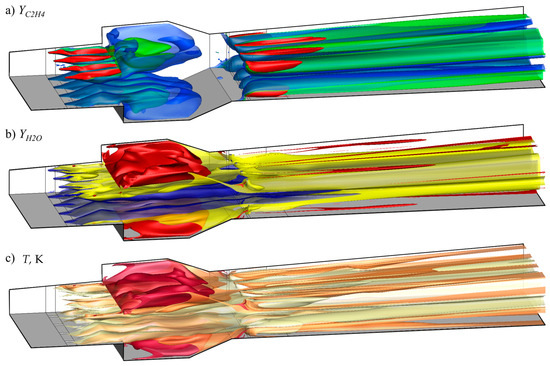
Figure 14.
Combustor flowfield near the cavities at ms: (a) isosurfaces of (blue = 0.001, green = 0.01, red = 0.1), (b) isosurfaces of (blue = 0.01, yellow = 0.05, red = 0.1), and (c) isosurfaces of T (yellow = 2500 K, orange = 3000 K, red = 3500 K).
To investigate combustion within the cavities, Figure 14b shows the isosurfaces of the combustion product mass fraction () and Figure 14c shows the isosurfaces of temperature. The recirculating flows inside the cavities exhibit relatively low flow velocities and high pressures, both conducive to ignition and sustained combustion. Continuous fuel entrainment into the cavities replenishes the reactive mixture, supporting ongoing combustion and resulting in elevated temperatures, with peak values reaching approximately 3500 K near the frontal cavity ramps. These high temperatures arise from the combined effects of chemical heat release, aerodynamic process, and viscous dissipation near the cavity walls. The presence of both high temperatures and significant product concentration indicates intensive reactions, confirming the cavities’ flameholding capabilities. Notably, large regions within the cavities exhibit = 0.1, indicating widespread combustion. In contrast, the downstream regions aft of the secondary injectors show minimal combustion products, suggesting that the flamefront has not yet propagated into the near-wall separated flow zones.
The current combustor demonstrates a strong capability for rapid mixing and combustion, as indicated by the observed fuel and product flowrates downstream of the cavity region in the exhaust nozzle. Figure 15 shows the distributions of fuel mass fraction (+), temperature, and water mass fraction () on the sidewall, bottom wall, and across several transverse planes at various axial locations at t = 8 ms. The aft-cavity region functions as an active reactive zone, as evidenced by the decreasing fuel mass fraction along the axial direction. Combustion products, except in a narrow zone near the flowpath centerline corresponding to the supersonic core, disperse both transversely and spanwise, occupying the majority of the nozzle cross-section. Over the 4 ms interval from t = 4 ms (Figure 14b) to 8 ms (Figure 15c), the previously isolated reaction zones in the expansion region downstream of the secondary injectors spread into the near-wall separated flow regions. By t = 8 ms, most of these regions exhibit ≥ 0.1, indicating sustained combustion. Elevated temperatures in the exhaust nozzle, driven by both chemical heat release and convective heat transfer, underscore the importance of thermal management in practical applications.
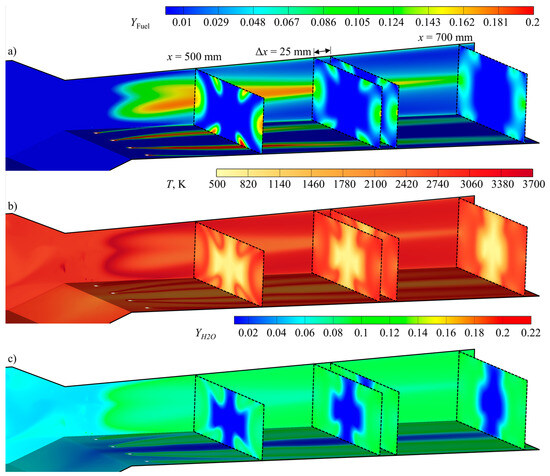
Figure 15.
Aft cavity flowfield in the exhaust nozzle at t = 8 ms. (a) Fuel mass fractions, (b) Temperature, (c) H2O mass fractions.
Mass flowrates are also integrated across regularly spaced transverse planes at various axial locations. These planes are spaced 12.5 mm apart, starting with the first plane at x = 500 mm, which is located 80 mm downstream of the secondary injector arrays to exclude contributions from the fuel plumes. The final plane is positioned at x = 700 mm, immediately upstream of the domain outlet. Figure 16 illustrates the temporospatial variations by comparing the temporal evolution of the results integrated over these planes. The total mass flowrate () encompasses species from fuel, air, and burnt products. Mass flowrates are also tracked for individual fuels: methane () and ethylene (), as well as the percentage of unburnt total fuel (%Unburnt). Shortly after the injectors are activated, a noticeable spike in occurs throughout the region at t = 0.16 ms. The spike reflects the flow adjustments upon injector activation. Fuel injection triggers the rapid formation of bow shocks and separation regions near the injector arrays, leading to fluctuating fuel mass flowrates from the injectors. The duration of these fluctuations provides insights into the time required to reach a post-injection local flow equilibrium. This spike quickly diminishes, settling into a slow cyclical variation by t = 1 ms, suggesting steady fuel injection and successful combustion initiation. Note that the total fuel mass flowrate entering the combustor is recorded separately, and its value remains constant at approximately 0.0618 kg/s, with negligible variation. The profiles of and exhibit similar trends, with approximately double the level of , reflecting the binary fuel mixture―64% ethylene and 36% methane―introduced into the combustor. During the combustor transient stage, although the remnant fuel mass flow rates at each location vary over time, they consistently decrease along the length of the aft cavity region, suggesting distributed combustion regions in the axial direction.
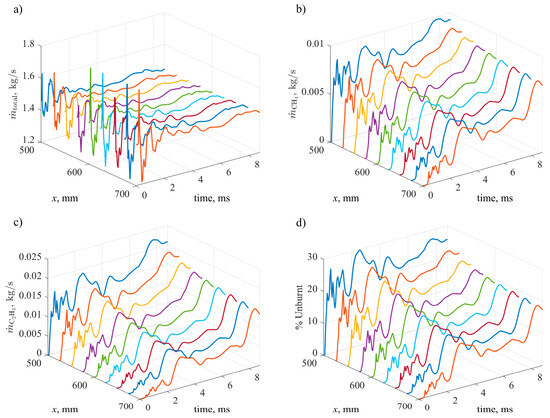
Figure 16.
Mass flowrates in the aft cavity flowfield during 0.05 ms 8 ms. (a) Total mass flow rates, (b) CH4 mass flow rates, (c) C2H4 mass flow rates, (d) Unburnt fuel percentage.
Figure 16d illustrates the combustion completeness by tracking the percentage of unburnt fuel. Temporospatial variations in unburnt fuel during 0.05 ms ≤ t ≤ 8 ms show that, on average, 24% of the total fuel injected is combusted in the aft cavity region, specifically in the region of 500 mm ≤ x ≤ 700 mm. The analysis of the x = 700 mm plane facilitates the quantification of unburnt fuel exiting the domain. During the initial combustion, from 0.3 ms to 1.5 ms, the percentage of unburnt fuel leaving the exhaust nozzle averages around 15%, peaking at 20% at t = 1.3 ms. As the mixing intensifies and combustion is established, this percentage reaches a maximum of 30% at t = 2.5 ms. In the quasi-steady state at t > 7 ms, it fluctuates between 12% and 20%. A dual-cavity scramjet combustor [32] had an unburnt ratio of about 22–44%, while for a single-cavity combustor [25], 30% unburnt fuel was recorded. Current predictions for the dual opposing cavity configuration suggest improved combustion efficiency within the established ranges.
4.4. Quasi-Steady Reacting Flowfields
As the flames and shock waves are established in the combustor, the flowfield reaches a quasi-steady state. Figure 17 shows contours of pressure, temperature, and Mach number on the midplane, and profiles of wall pressure on the midplane top and Mach number along the centerline at t = 8 ms. The pronounced variations in pressure illustrate the established shock systems discussed earlier. The highest pressure values are found in the core flow near the injectors, where strong bow shocks induced by fuel penetration interact with each other and with additional shocks or shear layers. Due to chemical heat release and aerodynamic processes, temperatures peak near the primary fuel injectors and within the cavities, indicating sustained combustion. High temperatures also occur near the secondary injectors but decrease due to enhanced heat transfer near the walls. While the core-flow temperature remains around 1200 K in the nozzle, ongoing reactions and heat transfer increase the near-wall temperature to about 2000 K, suggesting the need for thermal protection.
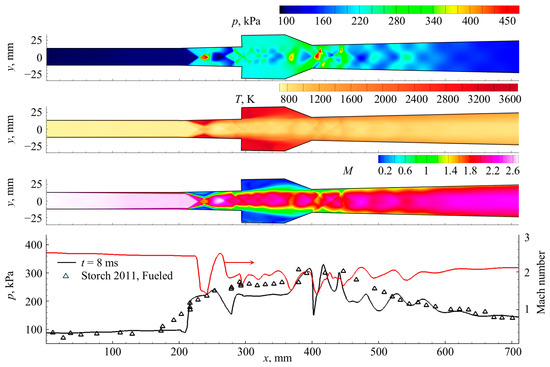
Figure 17.
Contours of pressure, temperature, and Mach number on the midplane, and profiles of the wall pressure and centerline Mach number at t = 8 ms [16].
The Mach number contour highlights the leading shocks generated by fuel injection and high backpressure, with a rapid decrease near x = 230 mm. These shocks then reflect off the shear layers, transforming into expansion fans that create a sharp spike near x = 250 mm. The processes of flow expansion and shock reflection continue downstream, gradually diminishing in strength as they traverse the combustor region. Nevertheless, Mach numbers along the centerline consistently stay supersonic throughout the flowpath, indicating that the current flight speed and inlet conditions are above those typical of dual-mode operation and align with the scramjet-only regime. The wall pressure profile mirrors the experimental results, though with sporadic regions of lower pressure. In the experiment, the pressure rise begins at x = 178 mm, upstream of the primary injectors, whereas in the numerical analysis, this pressure increase is observed at x = 210 mm. The delayed initial pressure rise and the overall similarity in pressure profiles align with previous simulation results reported in [16].
5. Conclusions
This study presents a detailed numerical investigation into the development and stabilization of the reacting flowfield within a scramjet combustor, which is equipped with two opposing cavity flameholders. Verification and validation procedures were executed to assess the theoretical and numerical frameworks, as well as the grid resolution. These procedures demonstrated good grid convergence and reasonable agreements between the experimental results and numerical predictions.
The simulation begins with a fully developed cold flowfield without fuel injection. Upon commencement, fuel plumes from the inclined primary injectors and the perpendicular secondary injectors induce bow shocks upon entering the supersonic core flow. These shocks, along with those formed at the diverging and converging sections of the flowpath, interact with each other and with the fuel plumes, leading to complex, unsteady flow dynamics in the combustor region during transient development. Flow recirculation is established in both cavities, characterized by elevated pressures and temperatures conducive to ignition and combustion. As reactive mixtures are entrained into these cavities, they function as flameholders, sustaining combustion.
Near the secondary injectors, normal fuel injection and intense shock interactions result in near-wall separated flows, creating another significant combustion zone. This leads to a sharp pressure increase, pushing the shock waves and disturbances upstream and elevating the pressure within the cavity region. Adverse pressure gradients then arise ahead of the cavities and near the primary injectors, promoting flow separation along the walls. Initially, the inclined primary fuel plumes remain close the top and bottom walls; however, as near-wall separation expands, these plumes penetrate deeper into the core flow, intensifying the interactions among shock waves and shear layers. This establishes a feedback loop between the dynamic wave motions and combustion processes. The combined effects of the cavity flameholders and near-wall separated regions facilitate sustained combustion and stable flame presence in the combustor.
The numerical wall pressure data presented herein exhibit a general correspondence with the experimental measurements, showing a delayed initial pressure rise that aligns with prior simulation results reported in the literature. Future research should further investigate this delay by employing advanced treatments of near-wall and separated flows, as well as implementing detailed chemical kinetic analyses.
Author Contributions
Conceptualization, L.Z., B.G.C. and V.V.; methodology, J.C.S., L.Z. and B.G.C.; software, J.C.S., L.Z., B.G.C. and V.V.; validation, J.C.S., L.Z. and B.G.C.; formal analysis, J.C.S. and L.Z.; investigation, J.C.S., L.Z. and B.G.C.; resources, L.Z. and V.V.; data curation, J.C.S.; writing—original draft preparation, J.C.S. and L.Z.; writing—review and editing, J.C.S. and L.Z.; visualization, J.C.S.; supervision, L.Z.; project administration, L.Z.; funding acquisition, L.Z. All authors have read and agreed to the published version of the manuscript.
Funding
This research was partly funded by the University of Texas at Arlington and partly by the NASA M-STAR under Grant No. 80NSSC23M0208.
Data Availability Statement
The original contributions presented in this study are included in the article. Further inquiries can be directed to the corresponding author.
Acknowledgments
The authors would like to express their gratitude to Cadence® for providing Fidelity Pointwise and to ANSYS® for providing the Academic Research Mechanical Licenses.
Conflicts of Interest
Authors Bruce G. Crawford and Valerio Viti were employed by the company Ansys Inc. The remaining authors declare that the research was conducted in the absence of any commercial or financial relationships that could be construed as a potential conflict of interest.
Nomenclature
| Ф | equivalence ratio |
| h | height |
| k | turbulent kinetic energy |
| l | length |
| M | Mach number |
| mass flow rate | |
| p | pressure |
| ρ | density |
| T | temperature |
| t | time |
| u, v, w | velocity components |
| x, y, z | spatial coordinates |
| X | species molar fraction |
| Y | species mass fraction |
| W | width |
| ω | specific turbulence dissipation rate |
| Subscripts | |
| C | combustor |
| I | isolator |
References
- Segal, C. The Scramjet Engine: Processes and Characteristics; Cambridge University Press: New York, NY, USA, 2009. [Google Scholar]
- Choubey, G.; Devarajan, Y.; Huang, W.; Mehar, K.; Tiwari, M.; Pandey, K.M. Recent Advances in Cavity-Based Scramjet Engine-A Brief Review. Int. J. Hydrogen Energy 2019, 44, 13895–13909. [Google Scholar] [CrossRef]
- Curran, E.T.; Murthy, S.N.B. Scramjet Propulsion; AIAA: Cambridge, MA, USA, 2001. [Google Scholar]
- Le, D.B.; Goyne, C.P.; Krauss, R.H. Shock Train Leading-Edge Detection in a Dual-Mode Scramjet. J. Propuls. Power 2008, 24, 1035–1041. [Google Scholar] [CrossRef]
- Lin, K.C.; Tam, C.J.; Jackson, K.R.; Eklund, D.R.; Jackson, T.A. Characterization of Shock Train Structures Inside Constant-Area Isolators of Model Scramjet Combustors. In Proceedings of the 44th AIAA Aerospace Sciences Meeting and Exhibit, Reno, NV, USA, 9–12 January 2006. AIAA Paper 2006-816. [Google Scholar] [CrossRef]
- Lin, K.C.; Tam, C.J.; Jackson, K.R.; Eklund, D.R.; Jackson, T.A. Effects of Temperature and Heat Transfer on Shock Train Structures Inside Constant-Area Isolators. In Proceedings of the 44th AIAA Aerospace Sciences Meeting and Exhibit, Reno, NV, USA, 9–12 January 2006. [Google Scholar] [CrossRef]
- Kumar, S.; Pandey, K.M.; Sharma, K.K. Recent Developments in Technological Innovations in Scramjet Engines: A Review. Mater. Today 2021, 45, 6874–6881. [Google Scholar] [CrossRef]
- Li, X.P.; Liu, W.D.; Yang, L.C.; An, B.; Pan, Y.; Zhu, J.J. Experimental Investigation on Fuel Distribution in a Scramjet Combustor with Dual Cavity. J. Propuls. Power 2018, 34, 552–556. [Google Scholar] [CrossRef]
- Vinogradov, V.A.; Shikhman, Y.M.; Segal, C. A Review of Fuel Pre-Injection in Supersonic, Chemically Reacting Flows. Appl. Mech. Rev. 2007, 60, 139–148. [Google Scholar] [CrossRef]
- Minato, R.; Ju, Y.; Niioka, T. Numerical Analysis of Combustion Around a Strut in Supersonic Airflow. Trans. Jpn. Soc. Aeronaut. Space Sci. 2000, 43, 143–148. [Google Scholar] [CrossRef]
- Stouffer, S.D.; Baker, N.R.; Capriotti, D.P.; Northram, G.B. Effects of Compression and Expansion Ramp Fuel Injector Configuration on Scramjet Combustion and Heat Transfer. In Proceedings of the AIAA Aerospace Sciences Meeting and Exhibit, Reno, NV, USA, 11–14 January 1993. AIAA Paper 93-0609. [Google Scholar] [CrossRef]
- Jacobsen, L.S.; Gallimore, S.D.; Schetz, J.A.; O’Brien, W.F. Integration of an Aeroramp Injector/Plasma Igniter for Hydrocarbon Scramjets. J. Propuls. Power 2003, 19, 170–182. [Google Scholar] [CrossRef]
- Li, J.; Zhang, L.; Choi, J.Y.; Yang, V.; Lin, K.C. Ignition Transients in a Scramjet Engine with Air Throttling Part 1: Nonreacting Flow. J. Propuls. Power 2014, 30, 438–448. [Google Scholar] [CrossRef]
- Li, J.; Zhang, L.; Choi, J.Y.; Yang, V.; Lin, K.C. Ignition Transients in a Scramjet Engine with Air Throttling Part 2: Reacting Flow. J. Propuls. Power 2015, 31, 79–88. [Google Scholar] [CrossRef]
- Mathur, T.; Lin, K.C.; Kennedy, P.; Gruber, M.; Donbar, J.; Jackson, T.; Billig, F. Liquid JP-7 Combustion in a Scramjet Combustor. In Proceedings of the 36th AIAA/ASME/SAE/ASEE Joint Propulsion Conference and Exhibit, Las Vegas, NV, USA, 24 July–28 July 2000. AIAA Paper 2000-3581. [Google Scholar] [CrossRef]
- Storch, A.; Bynum, M.; Liu, J.; Gruber, M. Combustor Operability and Performance Verification for HIFiRE Flight 2. In Proceedings of the 17th AIAA International Space Planes and Hypersonic Systems and Technologies Conference, San Francisco, CA, USA, 11–14 April 2011. AIAA Paper 2011-2249. [Google Scholar] [CrossRef]
- Davidson, D.; Ren, W.; Hanson, R. Experimental Database for Development of a HiFiRE JP-7 Surrogate Fuel Mechanism. In Proceedings of the 50th AIAA Aerospace Sciences Meering Including the New Horizons Forum and Aerospace Exposition, Nashville, TN, USA, 9–12 January 2012. AIAA Paper 2012-0620. [Google Scholar] [CrossRef]
- Puri, P.; Ma, F.; Choi, J.Y.; Yang, V. Ignition Characteristics of Cracked JP-7 Fuel. Combust. Flame 2005, 142, 454–457. [Google Scholar] [CrossRef]
- Tang, T.; Sun, M.; Yan, B.; Wang, Z.; Yu, J.; Huang, Y.; Wang, H.; Zhu, J. Flow Structures and Combustion Regimes in an Axisymmetric Scramjet Combustor with High Reynolds Number. J. Fluid Mech. 2024, 1000, A3. [Google Scholar] [CrossRef]
- Tang, T.; Wang, Z.; Huang, Y.; Sun, M.; Wang, H. Investigation of Combustion Structure and Flame Stabilization in an Axisymmetric Scramjet. AIAA J. 2023, 61, 585–601. [Google Scholar] [CrossRef]
- Tang, T.; Wang, Z.; Yu, J.; Huang, Y.; Sun, M.; Wang, H.; Zhao, G.; Yang, Y.; Xiong, D. Investigation of Multi-Scale Flow Structures and Combustion Characteristics in a Cavity-Enhanced Circular Scramjet. Combust. Flame 2024, 264, 113431–113447. [Google Scholar] [CrossRef]
- Choubey, G.; Pandey, K.M. Effect of Variation of Angle of Attack on the Performance of Two-Strut Scramjet Combustor. Int. J. Hydrogen Energy 2016, 41, 11455–11470. [Google Scholar] [CrossRef]
- Kummitha, O.R. Numerical Analysis of Hydrogen Fuel Scramjet Combustor with Turbulence Development Inserts and with Different Turbulence Models. Int. J. Hydrogen Energy 2017, 42, 6360–6368. [Google Scholar] [CrossRef]
- Kireeti, S.K.; Sastry, G.R.; Gugulothu, S.K. Numerical Investigation on Implication of Innovative Hydrogen Strut in Comparison with Multi Strut Injector on Performance and Combustion Characteristics in a Scramjet Combustor. Int. J. Hydrogen Energy 2022, 47, 41932–41946. [Google Scholar] [CrossRef]
- Kummitha, O.R.; Pandey, K.M.; Gupta, R. CFD Analysis of a Scramjet Combustor with Cavity Based Flame Holders. Acta Astronaut. 2018, 144, 244–253. [Google Scholar] [CrossRef]
- Westbrook, C.K.; Dryer, F.L. Simplified Reaction Mechanisms for the Oxidation of Hydrocarbon Fuels in Flames. Combust. Sci. Technol. 1981, 27, 31–43. [Google Scholar] [CrossRef]
- Menter, F.R. Two-equation Eddy-viscosity Turbulence Models for Engineering Applications. AIAA J. 1994, 32, 1598–1605. [Google Scholar] [CrossRef]
- Wilcox, D.C. Turbulence Modeling for CFD; DCW Industries: La Canada, CA, USA, 1998. [Google Scholar]
- Hoste, J.J.O.E.; Fossati, M.; Taylor, I.J.; Gollan, R.J. Characterisation of the Eddy Dissipation Model for the Analysis of Hydrogen-Fuelled Scramjets. Aeronaut. J. 2019, 123, 536–565. [Google Scholar] [CrossRef]
- Roache, P.J. Quantification of Uncertainty in Computational Fluid Dynamics. Ann. Rev. Fluid Mech. 1997, 29, 123–160. [Google Scholar] [CrossRef]
- Karthick, S.K. Shock and Shear Layer Interactions in a Confined Supersonic Cavity Flow. Phys. Fluids 2021, 33, 066102. [Google Scholar] [CrossRef]
- Choubey, G.; Pandey, K.M. Effect of Variation of Inlet Boundary Conditions on the Combustion Flow-Field of a Typical Double Cavity Scramjet Combustor. Int. J. Hydrogen Energy 2018, 43, 8139–8151. [Google Scholar] [CrossRef]
Disclaimer/Publisher’s Note: The statements, opinions and data contained in all publications are solely those of the individual author(s) and contributor(s) and not of MDPI and/or the editor(s). MDPI and/or the editor(s) disclaim responsibility for any injury to people or property resulting from any ideas, methods, instructions or products referred to in the content. |
© 2025 by the authors. Licensee MDPI, Basel, Switzerland. This article is an open access article distributed under the terms and conditions of the Creative Commons Attribution (CC BY) license (https://creativecommons.org/licenses/by/4.0/).